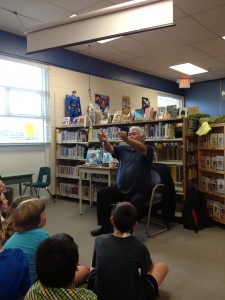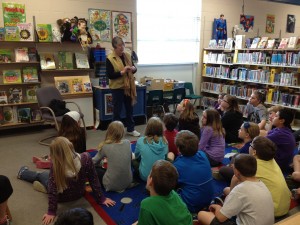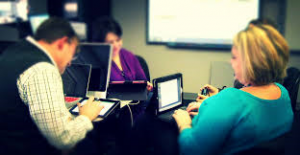In my mind, fostering a reading culture is a duty of the Teacher-Librarian, the administration and the classroom teachers. To truly foster a reading culture, everyone in the school setting needs to value reading and make it a priority in the school setting. Some of the ways I have done this include:
Family Read-In: Last year when I was working at another school library, we had a family read-in once a month. Parents, grandparents and community members were invited to read with kids all around the school. It was so amazing to see everyone reading for enjoyment. We would have buckets of library books in every room (computer lab, multi-purpose room, hallways) and students would grab a book and read for 20 minutes with a friend or family member. This really worked well and definitely fostered a culture of reading. It also allowed the kids to see teachers, parents, & community members all enjoying reading, un-interrupted.

Author Michael Kusugak storytelling at our library.
Author Visits: In our District we have money set aside from the District and PAC in each school to have author visits. Every year it is a different author but it really excites the kids. They get to talk to real authors about their jobs and begin to understand what a process it can be to publish a book. Students also make connections between reading and writing and are always excited to take out books written by an author they met!
10 Ways to Foster a Love of Reading
This author discusses that it is important to consider specific needs for specific populations. Thinking about school goals, and the themes that relate to the school you work in will help when selecting resources for the library.
http://www.edutopia.org/blog/cultivating-love-reading-students-elena-aguilar

Author Ann Walsh talking to the students about her experiences as an author.
Purchasing based on student Interest: I really like to set aside some of the money in the library budget to purchase books that meet student interest. Especially for struggling readers, purchasing books that will engage them is so important to me. As a Teacher-Librarian, I absolutely love seeing the excitement on a child’s face when they find a book they really love. Engaging them and encouraging them to love reading, is ultimately my job. I will often ask students about their interests and then order some books with certain students in mind. This week, I ordered some books on Lego. They were lower level readers, but I know some of the grade 3 boys who will be excited about these books. They are at their level and on a topic they are excited about.
Book Talks: I think part of fostering a love of reading is an excitement about books. When we get new books to the library, I love doing book talks to the classes and really building the excitement around the book. When kids come in to reserve a book, I know that they are excited about when they can get it and many of them come check every day to see if it has been returned!
Tumblebooks: These animated books really engage students and there are many popular titles. I show the kids how to use Tumblebooks from home to encourage them to use this resource. This is one of my favourite programs because it is a tool that kids can use independently regardless of their reading level. The books are read out loud and have animation and bright pictures. You can also access Tumblebooks (for free!) through the Greater Victoria Public Library by clicking on ebooks and more.
http://www.gvpl.ca/digital-content/ebooks-and-more/
Home Reading Program: This is my next goal for our school, setting up a home reading program that is run through the library and is school wide. I have spoken with some other Teacher Librarian’s in my District about what has worked well for them in their schools. There have been some great ideas! I think a home reading program can work really well because it ensures all kids are coming to the library regularly to collect their prize/get their next home reading sheet. It is a great way to engage with the students who aren’t regulars in the library. If anyone has any experience with a home reading program that they’ve seen work well at the whole school level, please share!
Partner with the Public Library: Last year, I had the Children’s librarian from the GVPL come to visit our school in June. She spoke about the program the Public Library offers during the summer and the summer reading program. Having her there definitely created excitement about using the library and encouraged kids to read over the summer.
Fostering a love of reading is a process but is important to focus on. As I start my new position, I am constantly looking for ways to engage my students with books and ensure that they are finding books they love in the library. Hopefully, by showing just how much I love reading, I will be setting a good example as well!









